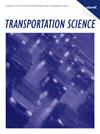动态拾取和公平分配问题
IF 4.8
2区 工程技术
Q1 OPERATIONS RESEARCH & MANAGEMENT SCIENCE
引用次数: 0
摘要
城市物流应用涉及货物的取货和配送,需要针对一组站点做出路由和分配决策。在事先不知道供应数量和供应时间的情况下,这些决策必须根据逐渐到达的信息实时做出。此外,在许多符合上述设置的应用中,除了系统效率之外,还需要公平分配。在本文中,我们考虑的问题是如何确定一条以任意顺序访问两类地点的车辆路线:取货点(PPs)和需求点(DPs),前者是车辆收集物资的地点,后者则是运送物资的地点。每个取货点提供的供应数量是不确定的,而有关其价值的信息会随着时间的推移逐渐到达。我们将这一问题建模为随机动态路由和资源分配问题,目的是在向 DP 公平分配资源的同时尽可能多地运送货物。我们为该问题提出了马尔可夫决策过程公式,但它受到维度诅咒的影响。因此,我们开发了一个启发式框架,它将运筹学和机器学习新颖地结合在一起,适用于许多动态随机组合优化问题。具体来说,我们使用大型邻域搜索(LNS)来探索可能的决策,并结合神经网络(NN)模型来近似任意状态和行动下的未来值。当决策空间太大而无法枚举时,我们提出了一种新的强化学习方法来训练神经网络。基于柏林粮食银行的数据和随机生成的数据集,我们对 38 到 180 个站点实例进行了数值实验,结果证实启发式获得的解决方案比三个基准解决方案分别平均高出约 28.2%、41.6% 和 57.9%:本研究得到了以色列科学基金会 [Grant 463/15]、特拉维夫大学 Shlomo Shmeltzer 智能交通研究所、以色列智能交通研究中心 (ISTRC) 和以色列高等教育委员会 (VATAT) 的部分支持:在线附录见 https://doi.org/10.1287/trsc.2023.0228 。本文章由计算机程序翻译,如有差异,请以英文原文为准。
The Dynamic Pickup and Allocation with Fairness Problem
Urban logistic applications that involve pickup and distribution of goods require making routing and allocation decisions with respect to a set of sites. In cases where the supply quantities and the time in which they become available are unknown in advance, these decisions must be determined in real time based on information that arrives gradually. Furthermore, in many applications that satisfy the described setting, fair allocation is desired in addition to system effectiveness. In this paper, we consider the problem of determining a vehicle route that visits two types of sites in any order: pickup points (PPs), from which the vehicle collects supplies, and demand points (DPs), to which these supplies are delivered. The supply quantities offered by each PP are uncertain, and the information on their value arrives gradually over time. We model this problem as a stochastic dynamic routing and resource allocation problem, with the aim of delivering as many goods as possible while obtaining equitable allocations to DPs. We present a Markov decision process formulation for the problem; however, it suffers from the curse of dimensionality. Therefore, we develop a heuristic framework that presents a novel combination of operations research and machine learning and is applicable for many dynamic stochastic combinatorial optimization problems. Specifically, we use a large neighborhood search (LNS) to explore possible decisions combined with a neural network (NN) model that approximates the future value given any state and action. We present a new reinforcement learning method to train the NN when the decision space is too large to enumerate. A numerical experiment with 38 to 180 site instances, based on data from the Berlin Foodbank and randomly generated data sets, confirms that the heuristic obtains solutions that are on average approximately 28.2%, 41.6%, and 57.9% better than three benchmark solutions.Funding: This research was partially supported by the Israel Science Foundation [Grant 463/15], by the Shlomo Shmeltzer Institute for Smart Transportation at Tel Aviv University, by the Israeli Smart Transportation Research Center (ISTRC), and by the Council for Higher Education in Israel (VATAT).Supplemental Material: The online appendix is available at https://doi.org/10.1287/trsc.2023.0228 .
求助全文
通过发布文献求助,成功后即可免费获取论文全文。
去求助
来源期刊

Transportation Science
工程技术-运筹学与管理科学
CiteScore
8.30
自引率
10.90%
发文量
111
审稿时长
12 months
期刊介绍:
Transportation Science, published quarterly by INFORMS, is the flagship journal of the Transportation Science and Logistics Society of INFORMS. As the foremost scientific journal in the cross-disciplinary operational research field of transportation analysis, Transportation Science publishes high-quality original contributions and surveys on phenomena associated with all modes of transportation, present and prospective, including mainly all levels of planning, design, economic, operational, and social aspects. Transportation Science focuses primarily on fundamental theories, coupled with observational and experimental studies of transportation and logistics phenomena and processes, mathematical models, advanced methodologies and novel applications in transportation and logistics systems analysis, planning and design. The journal covers a broad range of topics that include vehicular and human traffic flow theories, models and their application to traffic operations and management, strategic, tactical, and operational planning of transportation and logistics systems; performance analysis methods and system design and optimization; theories and analysis methods for network and spatial activity interaction, equilibrium and dynamics; economics of transportation system supply and evaluation; methodologies for analysis of transportation user behavior and the demand for transportation and logistics services.
Transportation Science is international in scope, with editors from nations around the globe. The editorial board reflects the diverse interdisciplinary interests of the transportation science and logistics community, with members that hold primary affiliations in engineering (civil, industrial, and aeronautical), physics, economics, applied mathematics, and business.
 求助内容:
求助内容: 应助结果提醒方式:
应助结果提醒方式:


